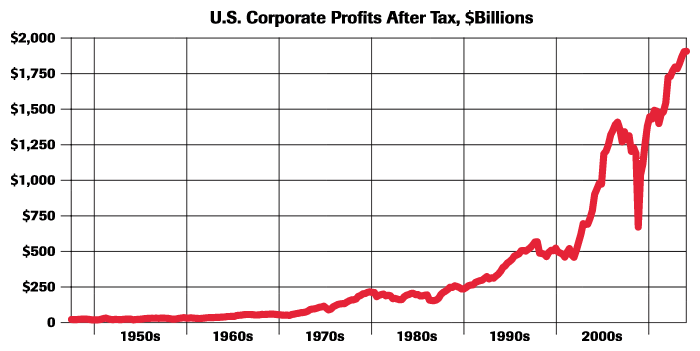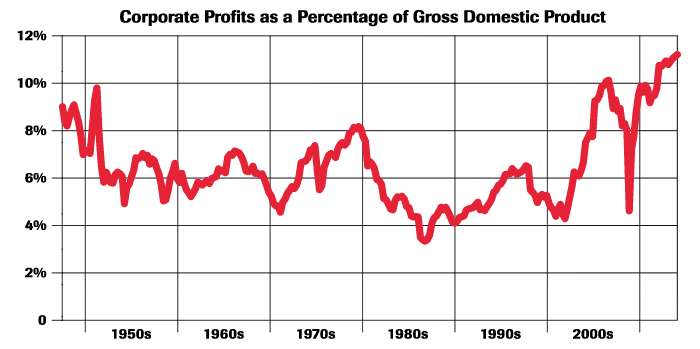2014 Q2 | Economy Thaws, Companies Move Abroad
 Let’s take a moment to look at the first half of 2014. Both stocks and bonds moved forward in the first half of the year. The S&P 500 gained 7.12%, and the Dow Jones Industrial Average gained 2.68%. The 10-year Treasury rate fell from 3.0% to 2.6%, resulting in a 2.1% increase in the price of this important benchmark. These results were consistent with a number of mixed signals coming from the economic recovery, which has continued to be on-again and off-again.
Let’s take a moment to look at the first half of 2014. Both stocks and bonds moved forward in the first half of the year. The S&P 500 gained 7.12%, and the Dow Jones Industrial Average gained 2.68%. The 10-year Treasury rate fell from 3.0% to 2.6%, resulting in a 2.1% increase in the price of this important benchmark. These results were consistent with a number of mixed signals coming from the economic recovery, which has continued to be on-again and off-again.
This in part is because the country experienced a severe winter, a bitter cold, and many weather-related economic disruptions. The result was that real gross domestic product fell 2.9% in the first quarter, considerably worse than the consensus expectations. We think first half weakness is only temporary and will result in a deferral of demand. Recent strong automobile sales coupled with improving housing demand suggest third quarter GDP could be up 3-4%. Because of the weak first half, the outlook on the balance of the year needs to be reasonably strong to reach our initial 3-4% full-year growth forecast. In order to err on the side of conservatism, our new forecast calls for growth to be in the 2-2.5% range.
News on the employment front improved throughout the first half. In June, total employment reached the 2007 pre-recession highs (7 years ago!). Monthly gains in employment are now exceeding 225,000, enough to absorb new entrants in the labor force, a big positive. ADP, a major payroll servicing company with a vast labor database, reports that small and medium-sized businesses are increasing hiring for the first time in many years. Unemployment could fall below 6% by year end, the lowest level since 2008.
Corporate profitability continues to be a bright spot in the United States. Currently, profits are at record levels. We are forecasting a 7% gain in 2014 and a further 9% increase next year. This forecast provides reasonable support for today’s equity valuations. Of concern is that for the last eight quarters revenue gains have lagged profit growth, an unfavorable trend that needs to correct itself. We believe it will. The relationship between sales growth and profit growth means that profit margins have reached record levels (shown on page three), a trend that can only be sustained for so long without a resumption of stronger revenue growth.

The outlooks for interest rates and inflation, which are closely correlated, are both sending mixed messages. We have been expecting higher interest rates as the recovery gains momentum, supporting increased credit demands and higher loan rates. Perhaps the miserable weather in the first quarter derailed our forecast, as interest rates actually fell in the first half. Also, a new Federal Reserve Chair, Janet Yellen, is implementing her initiatives on Federal Reserve policies, and these could be having an effect on the markets. The early read on the Yellen era suggests she is an “easy money” person, implying interest rates should remain low at least for the near-term. Ultimately, we see this as leading to higher rates, but not until late 2015.
We also expect a rising level of inflation, resulting from upward pressure on wages, which could come as early as the fourth quarter of 2014. More disturbing, a trend of moderating, even declining, levels of worker productivity is a negative, resulting in an increase in unit labor costs (percentage wage gains – percentage productivity = percentage unit labor cost change). Historically, wage increases have been offset by productivity gains, resulting in stable unit labor costs, which enable non-inflationary improvements in wages and median family income levels. Recent negative trends in productivity bear close watching, as they could result in increases in unit labor costs, a good proxy for predicting inflation.
Our initial forecast for 2014 called for US economic growth to be in the 3-4% range, accompanied by a 2% inflation factor. At the halfway mark of this year, we suggest GDP growth will be at best at the lower end of the range, 2–2.5%, but we maintain our expectations for CPI and interest rates.
There have been a number of geopolitical and strategic economic issues that developed in the first half that could have longer-term implications for world economic growth. First, two major energy-producing nations have experienced unusual challenges. In the spring Russian leader Putin annexed Crimea and threatened the Ukraine with occupation. In turn, the West threatened sanctions, resulting in fears that Russia would withhold critically needed natural gas supplies from Western Europe. The Russian geographic expansionist actions, rare since World War II, were common in centuries past and often led to war. Let us hope we will not have to relearn the lessons of the past. Second, there were very unfavorable developments in the Middle East, specifically in Iraq, as a new, radical element of Al-Qaeda, Islamic State in Iraq and Syria (ISIS), incited a religiously driven civil conflict in Iraq and contributed to instability throughout the region, potentially threatening oil production in the Middle East.
[blockquote4 align=”left|center|right” textalign=”left|center|right” width=”30%”]Corporate profitability continues to be a bright spot in the United States. [/blockquote4]Iraq has been producing 3.1 million barrels of oil per day (out of a free world total of 87 million per day), and its production is significant to world oil supplies and therefore prices. The strong possibility that Iraqi oil production will be unstable in the coming months has clearly undermined our firm’s expectations of lower oil prices for the balance of the year. Of more concern would be if the radical ISIS, which has established a caliphate, should expand into larger areas in the region. ISIS has already announced its intention to expand to Jordan, Syria and Lebanon. This is a huge threat to Israel but even more worrisome is the potential to expand to the key oil-producing countries of Saudi Arabia, Kuwait and the United Arab Emirates. Today’s Middle Eastern developments are eerily similar to the events that led up to the outbreak of World War I, which were brilliantly detailed in Barbara Tuchman’s book The Guns of August.
Another area of concern is the gridlock in Washington. Surveys show the country has a very unfavorable rating of President Obama and an even lower rating of Congress. One result may have been the defeat of House Majority Leader Eric Cantor in Virginia’s Republican primary. This unprecedented event may indicate a huge backlash against all incumbents in November.
Washington’s failure to deal with day-to-day issues could be hurting our economy, as uncompetitive corporate income tax policies are certainly damaging our economy. American companies have approximately $2 trillion in surplus cash trapped in overseas banks because to bring the earnings home would subject them to a second round of corporate tax upon repatriation. We are the only major economy to impose a double tax on foreign earnings returning to home-based corporations.

Clever tax lawyers have come up with ways to avoid these taxes through a process known as inversion. In an inversion, American companies merge with a foreign entity and move the combined enterprise’s headquarters to the foreign company’s country of incorporation, effectively renouncing the US headquarters as its domicile. The new company then pays one tax bill to a foreign tax authority, typically in the U.K., Ireland, or Switzerland and the resulting tax rate is substantially below the US corporate tax rate. Two years ago, Cleveland-based Eaton Corporation acquired Irish based Cooper Industries and moved the entire company’s domicile from the US to Ireland. The effective tax rate declined from 13% to 2.5%.
Only recently have the powers in Washington started to realize the implications of a broad acceptance of these inversions and the potential danger it poses to America’s global competitiveness in the near-term. Can Americans really run the risk of losing our corporate crown jewels over antiquated corporate tax policies?
To close on a brighter note, spring weather conditions in the heartland of the United States have been nearly ideal for the farming sector, and the outlook for the summer crop harvest is excellent, possibly resulting in lower agricultural prices, which could have a favorable impact on food prices and inflation later this year. Business confidence remains strong, and a number of companies are “reshoring” (also known as relocating), as manufacturing operations move from overseas locations back to the United States. The slow growth in wages in the US in recent years has made this country very competitive with Western European and Japanese manufacturers. As noted previously, the US demography for supplies of workers is among the best of the economically developed economies. Though domestic labor participation rates have fallen slightly as the “Baby Boomers” have begun retiring, we still have a reservoir of skilled workers to meet the labor needs of the economy if the recovery gains steam as we expect.
[blockquote4 align=”left|center|right” textalign=”left|center|right” width=”30%”]Can Americans really run the risk of losing our corporate crown jewels over antiquated corporate tax policies? [/blockquote4]As this is written, two stock market indices have reached new all-time highs: 17,000 for the Dow and 1,985 for the S&P. Both indices are near the upper range of our forecasts for 2014. However, I sense a growing consensus that the “Great Recession” is finally coming to an end, and the economy is gaining momentum. This should result in an acceleration of growth in earnings, which has historically been the key to higher stock market values. So, for the balance of the year, we believe that investors in equities can experience some further modest gains.
Our outlook for bonds is tied to our interest rate forecast, which anticipates higher rates as the economy heats up and credit demands recover as both housing and automobile sectors have experienced recent strength. An interest rate increase in the near term appears unlikely, but we believe an increase is likely in 2015. For the balance of this year, we believe that the watchword should be “non-inflationary recovery continues.”



